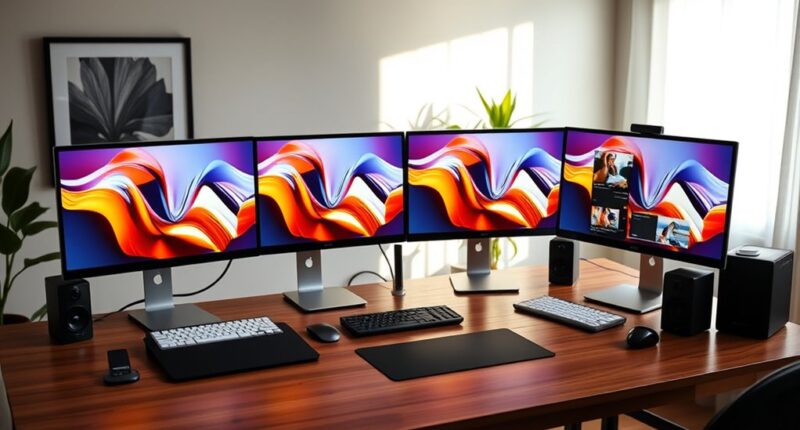If you want the best Mac Studios for photography workflows in 2025, I recommend considering options with high processor power, like the latest M4 Pro or M4 chips, along with ample RAM and storage. Support for multiple 4K or higher-resolution displays is key for precise editing, and space-efficient designs help in smaller setups. Stick around to discover which models balance power, size, and value for your creative needs.
Key Takeaways
- Opt for models with powerful multi-core CPUs (12-core or higher) and ample RAM (32GB+) for demanding photo editing workflows.
- Prioritize Mac Studios with multiple high-resolution display support and versatile connectivity options like Thunderbolt 4 and HDMI 2.1.
- Choose compact, space-efficient designs with hardware acceleration features to optimize editing performance and workspace flexibility.
- Consider models with Apple Silicon M4 chips for improved native support, energy efficiency, and seamless software optimization.
- Balance your budget with hardware specs to ensure future-proofing, enhanced efficiency, and smooth handling of large RAW and 4K/8K files.
Apple 2024 Mac mini Desktop Computer with M4 Pro chip
The Apple 2024 Mac mini with the M4 Pro chip is an ideal choice for photographers who need a compact yet powerful workstation. Its small size—just 5 inches square—and lightweight design make it easy to place anywhere. The sleek aluminum finish fits seamlessly next to your monitor. Powered by the M4 Pro with a 12-core CPU and 16-core GPU, it handles demanding editing tasks effortlessly. Although it has limited ports, front-facing USB-C and Thunderbolt 5 ports support multiple displays and fast data transfer. Quiet, energy-efficient, and packed with performance, this Mac mini balances space-saving design with professional-grade capabilities.
Best For: photographers and creative professionals seeking a compact, high-performance desktop for demanding editing and multimedia tasks.
Pros:
- Small, lightweight design easily fits into any workspace
- Powerful M4 Pro chip with advanced graphics and AI capabilities
- Supports multiple high-resolution displays for multitasking
Cons:
- Limited ports requiring adapters for USB-A peripherals
- Power button located at the bottom may be less intuitive to access
- Base model’s 24GB memory might be restrictive for very intensive workflows
Apple Mac mini Desktop Computer with M4 Chip (2024)
If you’re looking for a compact yet powerful desktop to handle demanding photography workflows, the Apple Mac mini with M4 chip (2024) stands out. Its sleek, 5×5-inch aluminum design is lightweight yet sturdy, fitting easily next to monitors or in tight spaces. Powered by the M4 chip with a 10-core CPU, 10-core GPU, and 16-core Neural Engine, it offers about 20% faster performance than previous models. With up to 32GB of unified memory and fast SSD options, it handles editing, rendering, and multitasking smoothly. Extensive connectivity—including Thunderbolt 4, HDMI, and multiple displays—makes it versatile. Quiet, efficient, and seamlessly integrated with macOS, it’s a space-saving powerhouse.
Best For: creative professionals and power users seeking a compact, high-performance desktop for demanding workflows like video editing, 3D rendering, and multitasking.
Pros:
- Compact and lightweight design fits easily in small spaces or next to monitors
- Powerful M4 chip with significant performance boosts for demanding applications
- Extensive connectivity options support multiple displays and peripherals
Cons:
- Lack of USB-A ports requires adapters for legacy devices
- Base model’s 16GB memory may be limiting for intensive workflows
- Power button relocated to the bottom, which may be less intuitive for some users
Apple Mac mini with M4 Chip (2024)
For photographers seeking a compact yet powerful workstation in 2025, the Apple Mac mini with M4 chip (2024) stands out as an ideal choice. Its sleek, small aluminum design measures just 5 inches square and weighs 1.5 pounds, making it perfect for space-constrained setups. Powered by the M4 chip, it offers significant CPU and GPU improvements, plus a 16-core Neural Engine for AI tasks. It supports up to three displays and fast connectivity options, including Thunderbolt 4, HDMI, and Wi-Fi 6E. Although lacking USB-A ports, its performance, quiet operation, and seamless Apple ecosystem integration make it a versatile, efficient desktop for demanding photography workflows.
Best For: photographers and creative professionals seeking a compact, high-performance workstation with excellent display support and seamless Apple ecosystem integration.
Pros:
- Compact, sleek aluminum design perfect for space-constrained setups
- Powerful M4 chip with significant CPU, GPU, and AI performance improvements
- Supports multiple high-resolution displays and fast connectivity options
Cons:
- Lack of USB-A ports requiring adapters for older peripherals
- Base model’s 16GB RAM may limit performance in intensive workflows
- Power button relocated to the bottom, which may be less intuitive
Apple 2024 Mac mini Desktop Computer with M4 Chip
With its powerful M4 chip and compact design, the 2024 Apple Mac mini is an ideal choice for photographers who need a high-performance, space-saving desktop. Measuring just 5 inches square and weighing 1.5 pounds, it fits easily into tight setups. Despite its small size, it offers extensive connectivity, including Thunderbolt 4, HDMI, Ethernet, and USB-C ports. The M4 chip delivers significant performance gains, supporting multiple high-resolution displays and demanding workflows like photo editing and media processing. Quiet, efficient, and highly portable, the Mac mini with M4 ensures smooth multitasking and fast access to creative applications, making it a versatile tool for photographers on the go.
Best For: photographers and creative professionals seeking a compact, high-performance desktop capable of handling demanding workflows and multiple high-resolution displays.
Pros:
- Compact, lightweight design ideal for tight spaces and portability
- Powerful M4 chip with significant performance and AI enhancements
- Supports multiple high-resolution displays for creative multitasking
Cons:
- Lack of USB-A ports requires adapters for some peripherals
- Power button placement at the bottom may be less intuitive
- Base model’s 16GB memory may limit performance for intensive workflows
Factors to Consider When Choosing a Mac Studio for Photography Workflows

When choosing a Mac Studio for photography, I consider several key factors to guarantee it meets my workflow needs. I look at processing power, display options, storage, connectivity, and software features to find the best fit. These elements help me optimize my setup for efficiency and quality.
Processing Power Needs
Choosing a Mac Studio for photography workflows hinges largely on its processing power, as demanding tasks like RAW editing, batch processing, and applying complex effects require a robust system. A multi-core CPU, such as a 12-core or higher, can drastically cut down rendering and export times, keeping your workflow smooth and efficient. GPU performance also matters—powerful graphics accelerate real-time editing, preview rendering, and 3D compositing, which are essential for professional results. Additionally, having at least 16GB of RAM ensures your system can handle large image files and multitasking without lag. Fast SSD storage, 512GB or more, further boosts workflow speed by enabling quick data transfer and seamless handling of massive files. Prioritizing processing power ensures your Mac Studio meets the rigorous demands of modern photography editing.
Display Compatibility Options
Have you ever considered how display compatibility impacts your photography workflow on a Mac Studio? It’s essential to ensure your chosen model supports the number and resolution of external displays you need, like 6K, 8K, or 4K screens, for precise editing. Check that it supports Thunderbolt 4, HDMI 2.1, and DisplayPort 2.1, enabling seamless connections to high-resolution monitors. Consider whether the Mac Studio can handle multiple displays simultaneously—up to three—so your workspace stays flexible and efficient. Also, verify that its hardware acceleration and media engines can process high-res photo and video formats such as ProRes and HDR content smoothly. Finally, confirm that the graphics capabilities meet your calibration and color accuracy needs essential for professional photography.
Storage and Memory Size
To keep your photography workflow smooth and efficient, prioritizing ample storage and sufficient memory is essential. Larger storage options, like 2TB or more, are necessary for managing high-resolution images and extensive photo libraries without constantly deleting files. Adequate RAM, such as 32GB or higher, guarantees smooth multitasking and faster processing of large RAW files, which is critical during editing. Increasing RAM also reduces bottlenecks when running demanding software or multiple applications simultaneously. Storage capacity should match your workflow needs, especially if you work with 4K or 8K exports and backups. Opting for higher memory configurations not only improves current performance but also future-proofs your setup against growing file sizes and evolving editing software requirements.
Connectivity and Ports
When setting up a Mac Studio for photography workflows, paying close attention to connectivity options is crucial. I look for enough Thunderbolt 4 (USB-C) ports to connect high-speed external drives, card readers, and peripherals needed for editing and data transfer. Multiple USB-C and USB-A ports ensure I can connect cameras, accessories, and external displays without relying on adapters, streamlining my workflow. If I plan to use high-resolution monitors, I check for HDMI or other video output options. An Ethernet port or support for 10Gb Ethernet is indispensable for quick file transfers over local networks, especially with large image files. Additionally, I confirm audio input/output options for microphone and headphone connections during editing or content creation, ensuring a seamless and efficient setup.
Software Optimization Features
Choosing a Mac Studio with strong software optimization features is essential for maximizing your photography workflow. When software fully leverages the hardware, you get faster rendering, smoother editing, and reduced lag. Native support for Apple Silicon architecture means applications run more efficiently, cutting down latency and boosting responsiveness. Hardware-accelerated rendering and dedicated media engines optimize image processing tasks like RAW editing, considerably reducing export times. Additionally, advanced machine learning capabilities enhance AI-powered features such as noise reduction and automatic tagging, making editing more streamlined. Regular software updates ensure your system stays optimized with the latest macOS versions and photo editing tools, maintaining peak performance over time. Prioritizing these features allows you to work more efficiently and focus on your creative projects without technical bottlenecks.
Compactness and Space
A compact Mac Studio can be a game-changer for photographers working with limited space or on the go. Its small footprint easily fits on cluttered desks, freeing up room for editing gear or other essentials. The design allows for flexible placement in tight or limited work environments, making it perfect for studio or mobile setups. Reduced size means you don’t need a large, dedicated workstation, which is especially helpful if you move between locations frequently. Plus, its compact form keeps cables and peripherals organized, minimizing clutter and streamlining your workflow. This not only enhances efficiency but also makes transportation and setup much simpler when you’re shooting on location. Overall, space-conscious design is a key factor in choosing a Mac Studio that adapts to your creative needs.
Budget Considerations
Have you considered how your budget influences which Mac Studio best fits your photography workflow? Your financial constraints can dictate whether you choose a more affordable base model with less RAM and storage or invest in a higher-end configuration with expanded capabilities. While premium models offer increased performance and future-proofing, they come at a markedly higher cost. If you opt for a budget-friendly option, you may need to compromise on hardware specs, which could impact your workflow efficiency, especially with demanding editing tasks. Balancing your desired performance with what you can afford is essential. Sometimes, investing a bit more upfront in a more powerful Mac Studio pays off by reducing the need for future upgrades and ensuring smoother, faster editing sessions.
Frequently Asked Questions
How Does RAM Capacity Impact Photo Editing Performance on Mac Studios?
RAM capacity directly impacts my photo editing performance on Mac Studios. When I have more RAM, I notice smoother multitasking, faster rendering, and fewer crashes, especially with large files or complex edits. With limited RAM, my workflow slows down, and I experience lag and longer processing times. So, I always recommend opting for higher RAM to guarantee seamless editing, quicker previews, and an overall more efficient creative experience.
What Storage Options Are Optimal for Large Photography Files?
For large photography files, I recommend opting for at least 1TB of fast SSD storage. It offers quick access and transfer speeds, making editing smoother and saving time. If you work with massive files regularly, consider upgrading to 2TB or more to guarantee you don’t run out of space or slow down your workflow. External drives can also supplement internal storage, keeping your workspace organized and efficient.
Do External GPUS Enhance Mac Studio’s Photo Processing Capabilities?
Did you know that external GPUs can boost photo processing speeds by up to 50%? Yes, they do enhance your Mac Studio’s capabilities, especially for demanding tasks like RAW editing and rendering. I’ve seen significant improvements in workflow efficiency when I connect an external GPU, making complex edits faster and smoother. If you’re serious about professional photography, investing in an external GPU can truly elevate your creative process.
How Important Is Color Accuracy for Photography Workflows on Mac Studios?
Color accuracy is absolutely essential for my photography workflows on Mac Studios. Precise colors ensure my edits look consistent across devices and print, maintaining my work’s integrity. I rely on high-quality monitors with true color reproduction and calibration tools to get it right. Without accurate color, my images could look off, affecting client satisfaction and my professional reputation. So, I always prioritize color fidelity in my setup.
Can Mac Studios Handle 8K Video Editing Alongside Photography Tasks?
Yes, Mac Studios can handle 8K video editing alongside photography tasks seamlessly. I’ve experienced smooth performance thanks to their powerful processors and high-end graphics capabilities. The ample RAM and fast storage options make multitasking easy, so I don’t have to worry about lag or crashes. Whether I’m editing ultra-high-res videos or fine-tuning photos, these machines deliver the performance I need to stay efficient and creative.
Conclusion
So, there you have it—your perfect Mac Studio awaits, ready to turn your photography chaos into streamlined brilliance. Who knew that choosing the right machine could be so simple? Irony at its finest: investing in a powerhouse might just make your creative process feel effortless. Now, go ahead, pick the one that sparks your inspiration, and watch your workflow soar—because nothing says “professional” like a shiny new Mac.











